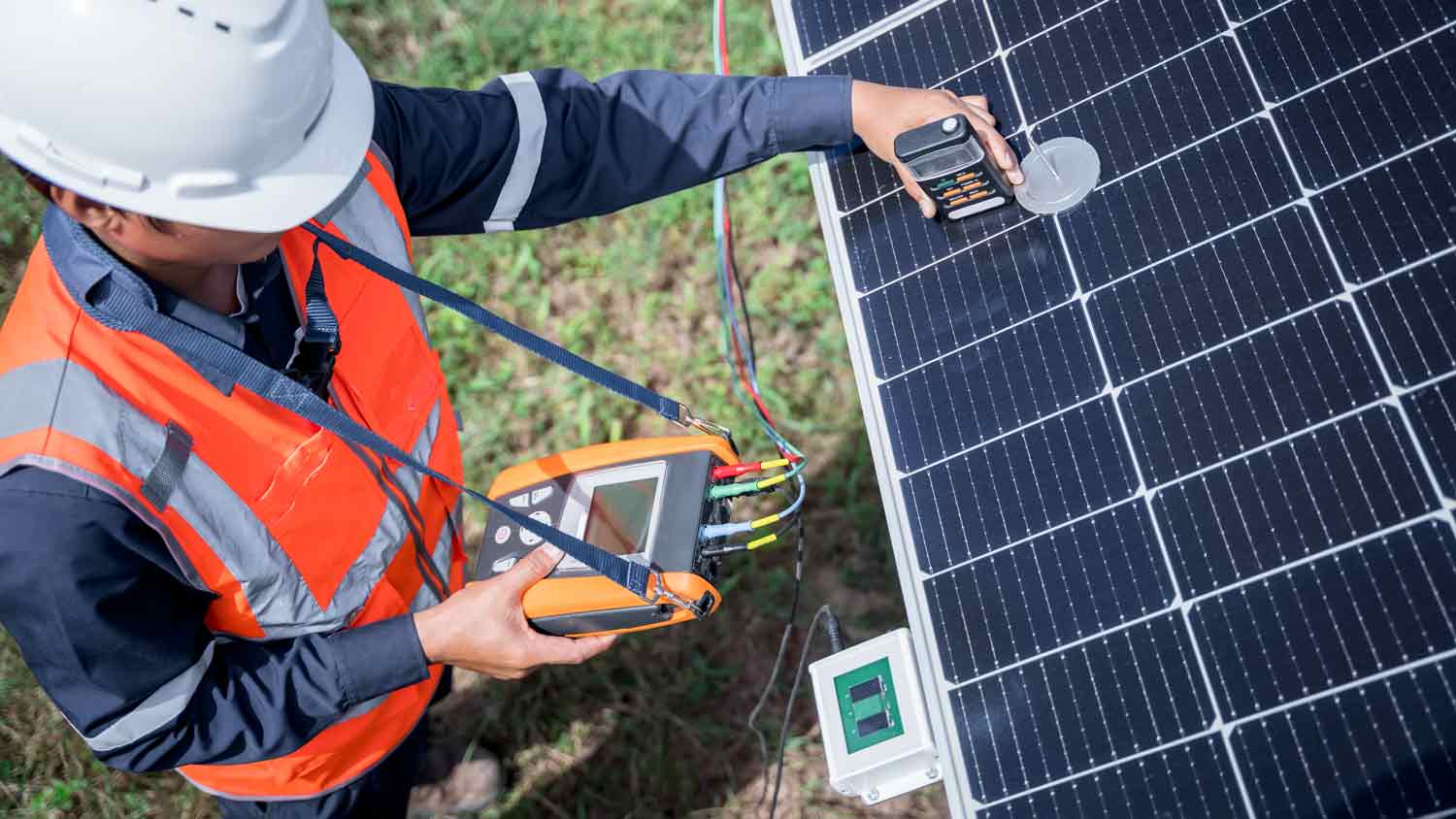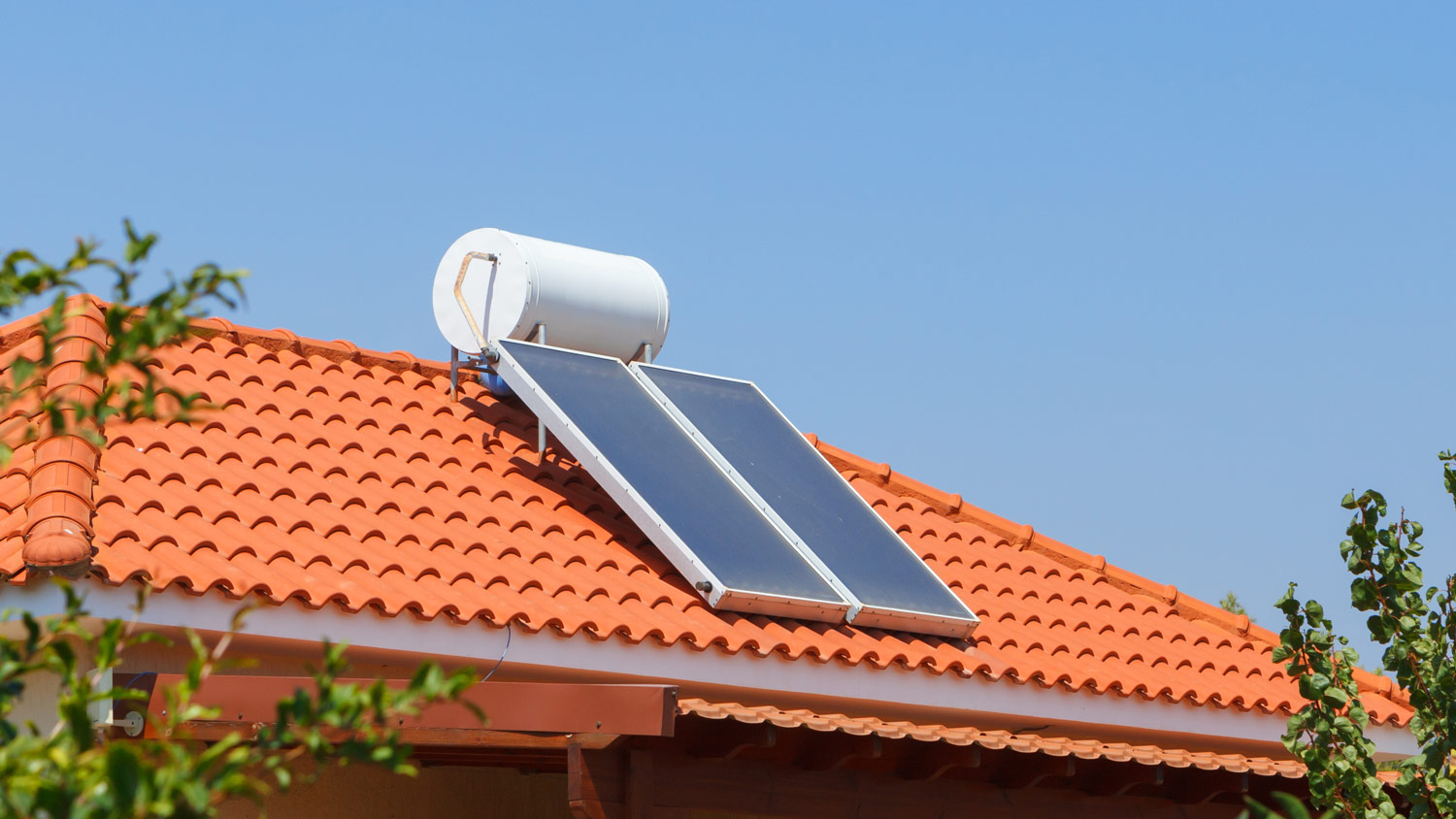
Discover the average solar panel installation cost, key price factors, and expert tips to help you budget for your solar project.
Power up your home’s value and save big on energy with solar panels


Home value rating: 3/5
Installing solar panels yields moderate returns that you can maximize with the help of a pro.
Homes with solar panels sell for $9,300 more on average than those without, according to Zillow.
With an average installation cost of $27,100, the return on investment (ROI) of solar panels is about 35%.
If you’re considering renewable energy features, installing solar panels might be worth it because they boost your home’s value. Solar panels add $9,300 to your home’s resale value on average, according to a Zillow study. Based on average costs from Angi customers, solar panel installation costs $18,400 to $36,400, yielding a solid ROI of about 35%.
The reasons behind this added value include lower energy bills for future buyers, growing demand for eco-friendly homes, and potential tax incentives. The exact return you can expect varies by state and by the quality of the job.
There are a few key factors that make the ROI of solar panels higher or lower, mainly: location, construction quality, and energy efficiency.
In some areas, solar panels can add more value to your home than in others. For example, homes in New York, New York; Orlando, Florida; and San Francisco, California had a higher resale value than the national average when equipped with solar panels, according to the Zillow study. Meanwhile, the resale values in Los Angeles and Riverside, California were somewhat below the national average.
The below table shows how much a home’s overall value increased on average when solar panels were added in different regions.
| Location | Increase in Overall Home Value |
|---|---|
| United States | 4.1% |
| New York, NY | 5.4% |
| Orlando, FL | 4.6% |
| San Francisco, CA | 4.4% |
| Los Angeles, CA | 3.6% |
| Riverside, CA | 2.7% |
Source: Zillow
Professionally installed solar panels can offer a higher ROI because they come with warranties, expert knowledge, and proper permits, all of which ensure the system operates efficiently and meets local regulations. Plus, if a potential homebuyer knows that an expert installed the solar panel system, they’ll feel more confident that it works properly.
DIY installations might save on labor costs initially, but they can lead to potential issues down the road, like inefficient energy production or even safety hazards. Hiring a solar panel installer near you can help you stay safe while maximizing the financial benefits of your solar investment.
The amount you pay for solar panel inspections and fees can impact the total ROI, depending on the costs. Local governments set permit requirements, and the cost varies. You can check your local government’s website to find your permitting costs.
Some states have capped their permitting fees. For instance, Colorado caps residential solar permitting fees at $500, and California’s cap is $450.
Solar panel inspections cost between $150 and $350 and depend on the location, labor costs, array size, type of inverter, and ease of access. When you have a solar panel inspection, you might also encounter additional maintenance and repair costs. Even though paying for inspections and fees will count against your ROI, these tasks and expenses help ensure your panels are running properly, which can increase energy efficiency and reduce future repair costs.
Maintenance includes routinely cleaning the solar panels, removing debris, checking components, and additional tasks that a solar maintenance company can handle periodically. Maintaining a solar panel system costs between $300 and $700. If the solar panels need repairs, it can cost as little as $20 for minor issues and up to $3,000 for more extensive repairs like a faulty power inverter.
When your home is equipped with solar panels, it’s not just about producing your own electricity—it’s also about using energy more efficiently. This efficiency can make your home more attractive to potential buyers and lead to a higher home value. In fact, more than 80% of buyers say that energy-efficient features are important to them when searching for a new home, Zillow reports.
Even if you don’t plan on selling your home anytime soon, you can recoup the costs of installing solar panels through energy savings over time. For example, homeowners in Orlando, Florida save an estimated $16,000 on energy costs over 20 years with solar panels, according to Google’s Project Sunroof. In New York City, the estimated savings in 20 years is over $32,000. You can find the estimated savings for your area with Project Sunroof’s calculator.
While solar panels don’t require too much maintenance, they do degrade over time and require regular inspections. If you’ve had your solar panels for longer, they may be less efficient and therefore less valuable to potential homebuyers.
With that said, by taking good care of your solar panels and addressing any maintenance needs promptly, you can ensure the solar panel system continues to provide reliable energy savings and extend its useful life span. It’s worth getting your solar panels inspected to catch any issues early on.
Based on Google’s Project Sunroof, you can see how the sun exposure, climate, and amount of space available for your solar panels will impact your energy savings over 20 years. This can help you determine how much you’ll save versus how much you’ll pay to install a solar panel system. You’ll likely get a better ROI on your solar panel cost in areas with greater sun exposure.
The solar panel orientation can also affect your ROI because the direction the panels face impacts their efficiency. Solar panels should face south for the most sunlight and best results. They can still produce energy while facing east or west, but production decreases by 10% to 20%. Systems facing north are the least effective and produce 30% less energy.
More efficient panels can help you recoup your energy costs faster, leading to a higher ROI.
With the above factors in mind, here’s how you can get a better understanding of the ROI of adding solar panels to your home.
Check Local Market Trends: Research how homes with solar panels are valued in your area. You can look for recent sales of comparable homes with solar panels to get a gauge on their value.
Estimate Energy Savings: Consider how much you’ll save on energy costs during the time you expect to stay in your home. One helpful tool is Google’s Project Sunroof, which provides energy savings estimates based on your address.
Consider Incentives and Rebates: There are many different local, state, or federal incentives for installing solar panels, which include tax breaks and direct rebates. Try searching the NC Clean Energy Technology Center database of incentives.
Calculate Cost Against Returns: Factor in the cost of labor, permits, and materials for installing solar panels. Once you have a better idea of the costs, you can hone in on how much of those costs you can make up for with energy savings and resale value.
Calculate Your Solar Payback Period: To determine your solar panel payback period—the amount of time it takes to break even on your investment—you’ll take the total cost of the solar panel system and subtract any rebates or tax credits. Then, divide that number by the amount you save on energy costs per year.
Calculate Your Solar Lifetime Savings: To get an idea of your solar lifetime savings, use a calculator like Google’s Project Sunroof. If you want to go a little further, you can compare your actual energy bills from before you installed solar to after. This will give you a good idea of your savings on a monthly or yearly basis.
Consult a Home Appraiser: For the most accurate valuation, a local home appraiser can provide insights into how solar panels affect home prices in your area and advise how to present these features to potential buyers.
On average, installing solar panels costs around $27,100, with most homeowners paying between $18,400 and $36,400. The exact price can vary based on the size and type of the solar system, your home’s energy needs, and your location.
If you spend about $27,000 on solar panel installation, you’ll recoup about one-third of the cost from its added resale value of $9,500.
The average solar panel payback period is between six and 10 years, but your actual payback period is highly dependent on the following factors:
The total cost of the system
Rebates and tax credits
Electricity bill savings
The amount paid toward the system per month
The U.S. Office of Energy Efficiency & Renewable Energy provides various examples and scenarios to help you understand how different circumstances, initial investments, and energy savings can impact the actual payback period.
Once your solar panels are paid off, they're officially your property. If you move, you can reinstall them on a new rooftop. Alternatively, they can increase the value of your home by 3% to 4% and attract more buyers. They can also give your property a competitive edge in a buyers’ market.
For many homeowners, solar panels are worth it—and that’s not only because they increase your home’s resale value. Various tax incentives, rebates, and longer-term energy savings can help cover the initial installation costs, making solar panels a smart financial move.
Beyond the financial benefits, solar panels help you reduce your carbon footprint and are environmentally friendly. This environmental benefit is a strong selling point for many homeowners who prioritize green living.
Whether solar panels are right for your home depends on your circumstances, including where you live, energy needs, and long-term goals. Here are the main pros and cons of solar energy to consider:
| Solar Panel Pros | Solar Panel Cons |
|---|---|
| Long-term energy savings | High initial installation costs |
| Increases home resale value | ROI depends on location |
| Reduces carbon footprint | Potential maintenance and repair costs |
| Eligible for tax incentives and rebates | Not all homes are suitable for solar panels |
| Provides energy independence |
Home is the most important place on earth, which is why Angi has helped more than 150 million homeowners transform their houses into homes they adore. To help homeowners maximize the value of their investments, we gather ROI data from reputable sources, including industry reports, real estate studies, and interviews with market experts. We calculate the average resale value for projects by multiplying the ROI against the project’s average cost according to our cost data, which is sourced from thousands of real Angi customers.
Want to help us improve our data? Send us a recent project quote or home appraisal value to [email protected]. Quotes and personal information will not be shared publicly.
From average costs to expert advice, get all the answers you need to get your job done.

Discover the average solar panel installation cost, key price factors, and expert tips to help you budget for your solar project.

Discover the average solar panel inspection cost, what impacts pricing, and how to save. Get expert tips to keep your solar system efficient and safe.

Get a clear estimate for solar water heater repair cost. Learn what impacts pricing and how to budget for your solar water heater repair.

Comparing solar quotes doesn’t have to feel like an overpriced guessing game. Find out how to properly compare your solar options here.

Solar farms can be profitable, but knowing exactly how to get the most out of your solar farm’s ROI is key to its success. Keep reading to learn more.

Solar batteries store excess energy from the solar panels for later use. If you want to learn more about how solar batteries work, you’ve come to the right place.